2. Chemical Department, Faculty of Engineering, Cairo University, Giza Governorate 12613, Egypt
2. ${affiVo.addressStrCn}
The demand for the increase of safety in the field of high energetic materials has focused on the progress of insensitive munitions (IM). The characteristics of IM decreases the chance of unwanted and sudden detonation by any external stimuli, and this can be accomplished by the enhancement of the explosive formulation by the preparation of insensitive high explosive or polymer bonded explosives (PBXs) [1-2].
The main purpose of requiring a replacement for RDX is that it is a slightly vulnerable explosive material with relatively high sensitivity to both im pact and friction. By contrast, FOX-7 is much less sensitive to impact and higher insensitive to friction, and its performance characteristics are comparable to RDX. In this regard, FOX-7 is a good candidate as an insensitive high explosive [3].
PBX is a term applied to an explosive material in which the crystals of the explosive are coated with a thin layer of polymeric binder. The selection of the way of production depends upon many factors prior to what is the purpose in which the explosive material will be used [4].
PBXs have many advantages compared to the pure explosives such as simplicity of the manufacturing techniques, lower vulnerability, and sensitivity to different mechanical and thermal stimuli increased shelf life because of its excellent resistance to humidity and chemical stability, enhanced mechanical properties and safe during production, handling, and storage [5].
Many researchers studied fragmentation warheads since the 1960s. Now those rocket warheads form one of the most commonly used and advanced kinds of ammunition because they have more advantages than blast warheads. The destructive effect of the blast wave from a conventional high explosive charge decreases significantly in proportion to the distance from the detonation point, but in the case of the fragmentation warheads, the fragments absorb a portion of energy in the form of kinetic energy, which carries them over greater distances to the target. After the detonation of the warhead; about approximately 30% of the energy released by the detonation of the explosive charge is used to fragment the warhead case and impart kinetic energy to the fragments. The importance of controlling the fragments is because of there is an optimum fragment size for attacking a target with a given warhead, to provide a sufficient number of fragments to guarantee a high hit probability and to afford an adequate destructive effect [6-10].
The static explosion test (arena test) of a controlled fragmentation warhead was used to determine the performance of the prepared PBXs samples by measuring the effects of its detonation to determine the lethal or effective zone of the tested warhead. The lethal (deadly) zone is one of the most im portant factors of the fragmentation warhead efficiency; it is the radius of an zone in which at least only one fragment hits the required target [11].
The main goal was to prepare different PBX formulations based on FOX-7 and both inert and energetic binders by casting technique to be used in controlled fragmentation warhead application to im prove the explosive properties (performance) and sensitivity of PBXs. The results were compared with those of the studied PBXs based on RDX.
2 Experimental Method 2.1 MaterialsThe inert prepolymer hydroxyl-terminated polybutadiene (HTPB), purity 99.5%, (milligram equivalents of OH per gram of HTPB=0.8456), the plasticizer dioctyl azelate (DOZ), purity 99%, and the high explosive 1, 3, 5-trinitro-1, 3, 5-triazinane (RDX), purity 98%, were supplied by Hangzhou Dayangchem Co., China, the bonding agent methyl aziridinyl phosphine oxide (MAPO), purity 99%, and the curing agent isophorone diisocyanate (IPDI), purity 99.5%, (milligram equivalents of NCO per gram of IPDI=9) were supplied by Aladdin Co., China, the energetic prepolymer glycidyl azide polymer (GAP), purity 99%, (milligram equivalents of OH per gram of GAP=1.429) was supplied by BOC Sciences, USA and the insensitive high explosive 1, 1-diamino-2, 2-dinitroethylene (FOX-7), purity 97.5%, was prepared in our laboratories through a three-stage preparation process.
2.2 Experimental Procedure 2.2.1 Preparation of PBXs Based on FOX-7/RDX and PU (based on HTPB)Two compositions of PBXs based on FOX-7/RDX and PU (based on HTPB) were prepared according to the following procedure:
A 1000 mL three-neck round-bottom flask equipped with a funnel, thermometer with lid, and a mechanical stirrer in a water bath was charged with HTPB, then mixed with two thirds of DOZ and MAPO under vigorous stirring for 15 min at a speed of 1000 r·min-1, the temperature was kept at 40 ℃ in the water bath during stirring. After increasing the temperature to 60 ℃, the explosive powder was then added in small portions during mixing for 30 min. Thorough mixing was conducted for about 15 min after complete addition of the explosive powder to get good mixing and ensure complete coating. The residual amount of DOZ and IPDI calculated, on the basis of NCO/OH=1.1, were added to the mixture and mixing continued for about 15 min at 40 ℃. The mixture of the formed matrix was cast and then pressed into the mold relevant to each test. The prepared PBX compositions were cured in a vacuum oven at 60-65 ℃ for 14 d, while the hardness test of shore variation of the samples was measured daily until no variation for at least three days is observed using the analogue hardness tester Bareiss HP-A-Shore durometer according to ASTM-D2240 testing standard technique at 25 ℃, which is required to be more than 40 [12].
2.2.2 Preparation of PBXs Based on FOX-7/RDX and PU (based on GAP)Two compositions of PBXs based on FOX-7/RDX and PU (based on GAP) were prepared by casting technique as in the previous case, except that HTPB was replaced by GAP and without the addition of DOZ or MAPO (not compatible with GAP).
The formulations are shown in Table 1.
| Table1 Compositions of the prepared PBXs based on FOX-7 / RDX and PU(GAP or HTPB) |
OZM ball fall hammer BFH-12A (made in the Czech Republic) was used to measure the impact sensitivity of RDX, FOX-7, and PBXs samples according to standard test method [13]. It consists of a falling hammer (six hammers with mass from 0.25 kg to 10 kg) moving on vertical rails provided with a calibrated scale up to 1 m. The device is capable of detecting sample sensitiveness within range of impact energies from 0.25 J to 100 J. The test results were reported as a relation between the impact energy of the drop weight and the percentage of initiations. The experiment was performed using a weight of 2 kg drop height was increased gradually.
2.4 Sensitivity to Friction DeterminationOZM BAM friction test apparatus FSKM-10 (made in the Czech Republic) was used to measure the friction sensitivity of RDX, FOX-7, and PBXs samples according to standard test method[13]. It consists of loading arms with notches, a standard set of 9 weights, porcelain pin and a rough porcelain plate of dimensions 25 mm×25 mm×5 mm, fixed in a movable table sliding at a constant speed between two marks by an electric motor. Sensitivity to friction was determined by spreading about 0.01 g of the tested sample on the surface of the porcelain plate in the form of a thin layer. Different loads were used to change the normal force between the plate and the porcelain pistil (friction forces in the range of 0.5 to 360 N).
2.5 Sensitivity to Heat DeterminationOZM AET-402 automatic explosion temperature tester (made in the Czech Republic) was used to measure the heat sensitivity of RDX, FOX-7, and PBXs samples according to standard test method [13]. It consists of a heating block provided with six vertical holes to accommodate test tubes filled by a small amount of Rose' s metal (for better heat transfer). The principle of the test is based on heating five samples of 0.2 g at a specifically selected heating rate until the ignition occurs. The temperature at which ignition of the sample occurs is assigned as ignition tem perature at the selected heating rate (5 ℃·min-1). The lowest temperature of the five measurements is reported as the ignition temperature of the tested sample at the applied heating rate. During the measurements; the heating rate must be constant because of the ignition temperature changes by varying the heating rate.
2.6 Detonation Velocity DeterminationExplomet-Fo®-2000 detonation velocity tester (made in Switzerland) [14], was used to measure the detonation velocity of RDX, FOX-7, and PBXs samples. It is consists of six synchronous timers which measure the time intervals between the illuminations of seven optical probes (sensors). This experiment was performed for the prepared pressed sample to 1.6 g·cm-3 which was filled in a PVC cylinder with dimensions (190 mm length, and 22 mm inside diameter) as shown in Fig. 1. Electric detonator No. 8 and a booster charge based on RDX were used to initiate the tested explosive charges, three samples were measured for each composition, and the mean value is reported.

|
Fig.1 Cartridge for measuring detonation velocity(unit: mm) |
OZM brisance by Kast method (made in the Czech Republic) was used to determine the performance of RDX, FOX-7, and PBXs samples as shown in Fig. 2.The brisance was measured by according to standard test method [13]. The sample was prepared by taking about 2.5 g, cast it into an aluminum tube of 12 mm inside diameter, 30 mm height, and 4 mm wall thickness, and then pressed it to density of 1.6 g·cm-3. This tube was placed on an easily movable steel cylinder, which is placed onto a copper cylinder in a precisely centered position with the aid of a particular guiding cylinder. A solid steel cylinder serves as a counterweight to the copper cylinder, and the movable steel cylinder helps to hold the investigated sample. The principle of the test is based on the initiating of the tested explosive sample by using detonator No. 8 and a booster charge based on RDX inside a detonation chamber, then measure the compression of the standard copper cylinder crusher (decreasing of its length) as a result of the explosive shock wave. The crusher made of high conductivity oxygen-free copper (HCOF copper) and has standard dimensions of 7 mm diameter and 10.5 mm height.

|
Fig.2 Arrangement for the brisance test |
Experimental arena tests were carried out with a controlled fragmentation warhead made from Ck45 steel, with dimensions (100 mm length, 30 mm outer diameter and 3 mm thickness) as shown in Fig. 3 according to the standard test method [15].
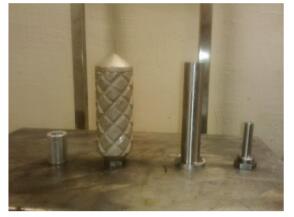
|
Fig.3 The tested controlled fragmentation warhead |
The warhead was placed at the position of explosion center and then put vertically on the ground at which the charge nose is in the down position as shown in Fig. 4 in the middle of the test zone to com pare the lethal efficiencies between similar warheads, where each warhead has the same (C/M). The test site should be in a flat and open region. The target is made of wooden target board with width of 1 m, height of 3 m and thickness of 10 mm and located at 10, 15, 20, 25, 30, 35 m away from the explosion center as shown in Fig. 5.
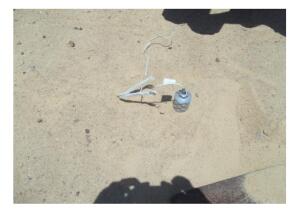
|
Fig.4 Arrangement for the arena test |
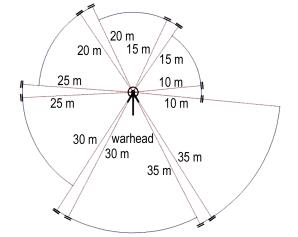
|
Fig.5 Typical small warhead arena test setup for similar warheads |
Electric detonator No. 8 was used to initiate the tested PBXs charges, the number of fragments that have penetrated through and those are stuck on the target board per square meter for each sector were counted after detonation; only one fragment perforation per square meter is required to measure the effective radius of each tested warhead. The lethal efficiency of the warhead increases with the increase of the effective radius [16-17].
3 Results and Discussion 3.1 Explosive PerformancesThe explosive performances of PBX formulations based on FOX-7 were compared to PBX formulations based on RDX as shown in Table 2.
| Table2 Sensitivity and performance of RDX, FOX-7 and the prepared PBX formulations |
It is clear that the impact sensitivity of FOX-7 and RDX decreased with the presence of a binder. However, PBX formulations containing polyurethane binder based on HTPB have lower sensitivity to im pact than those formulations based on GAP. For PBXGF4, the decrease of sensitivity to impact was 188.4%, when compared with PBXGR4. The measured upper limit of sensitivity to the friction of FOX-7 showed no indication of initiation according to friction was noticed even when applying the maximum force (360 N) of the test apparatus while it was measured as 120 N for RDX. However, for all other prepared PBX formulations based on FOX-7 or RDX and GAP or HTPB, no indication of initiation according to friction was noticed even when applying the maximum force (360 N) of the test apparatus. It was found that the ignition temperatures at the selected heating rate (5 ℃ ·min-1) for PBX formulations based on PU (GAP or HTPB) are less than that of FOX-7 and RDX; which can be attributed to the coating of PU (GAP or HTPB); that acts as a heat sensitizing medium because its softening temperature which is less than 152 ℃. For PBXGF4, the decrease of sensitivity to heat was 3.2%, when compared with PBXGR4.
It's clear that the velocity of detonation decreases with increasing the binder content. For PBX formulation based on HTPB, detonation velocity decreased by 9.9% but decreased by only 4.6% for that based on GAP when compared with that of FOX-7; this may be related to the energetic groups (oxygen atoms, azide groups) of GAP compared with HTPB. For PBXGF4, the increase of detonation velocity was 2.1%, when compared with PBXGR4.
It's clear that the brisance value for PBX based on PU/HTPB was decreased by 12.7% but decreased by 8.7% for that based on GAP when com pared with that of FOX-7. This decrease is related to the decrease of the high brisant explosive content (FOX-7) and hence the decreases of oxygen content, number of moles of gaseous products and detonation velocity of the prepared PBX formulations. For PBXGF4, the increase of brisance was 0.5%, when compared with that of PBXGR4.
3.2 Arena Test ResultsThe warhead lethality zone (radius) for the prepared PBX formulations is shown in Fig. 6 and Table 3. Because only one fragment is enough for affecting on or killing a target so, at the lethality fragment density of 1 frags/m2, a horizontal line was drawn then the warhead lethality zone for the tested fragmentation warheads was measured from the X-axis.
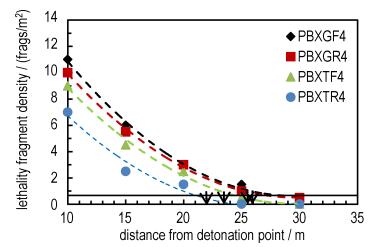
|
Fig.6 Warhead lethality zone of the tested warheads filled with the prepared PBX formulations |
| Table3 Lethal zone of the tested warheads filled with the prepared PBX formulations |
For PBXGF4, the increase of the warhead lethality zone was only 2%, when compared with that of PBXGR4, but it was 18.2%, when compared with that of PBXTR4. We can conclude that PBXGF4 based on FOX-7 and PU/GAP is the most suitable candidate formulation for filling the fragmentation warheads when compared with PBX formulations based on RDX and PU/HTPB.
4 ConclusionsIn this work, PBX samples based on FOX-7/RDX and PU (GAP/HTPB) with 14% binder has been successfully prepared by using casting technique. The sensitivity measurements to mechanical stimulus (impact, friction) of all the prepared samples proved that all the studied polymeric matrices decreased the sensitivity of the pure explosives. The measured sensitivity characteristics proved that PBXGF4 has lower sensitivity to impact and heat than that of PBXGR4 by 188.4% and 3.2% respectively. Its sensitivity to friction is the same as that of PBXGR4. PBXGF4 has higher performance parameters, in which detonation velocity increased by 2.1% and brisance increased by 0.5% when compared with that of PBXGR4. Filling of controlled fragmentation warheads by different PBXs have the different explosives fillers, and the same polymeric matrix showed that the tested samples based on FOX-7 and PU (GAP) gave higher lethal (deadly) radius (26 m) than that based on RDX or formulations based on PU (HTPB). Thus, we can say that FOX-7 has been as a replacement for RDX. PBXGF4 have several advantages: simplicity and ease of production, lower sensitivity to impact and insensitive to friction, appropriate heat sensitivity, increased safety, high performance (detonation velocity and brisance), high-efficiency radius (lethal zone) and can be applied for filling fragmentation warheads.
| [1] |
Daniel M. Polyurethane binder systems for polymer bonded ex-plosives [R]. Defense science and technology organisation, Re-port DSTO-GD-0492, Australia, 2006.
|
| [2] |
Badgujar D, Talawar M, Mahulikar P. Review of promising in-sensitive energetic materials[J]. Central European Journal of Energetic Materials, 2017, 14(4): 821-843. DOI:10.22211/cejem/68905 |
| [3] |
Trzcinski W, Belaada A. 1, 1-diamino-2, 2-dinitroethene(DADNE, FOX-7) -properties and formulations (a Review)[J]. Central European Journal of Energetic Materials, 2016, 13(2): 527-544. DOI:10.22211/cejem/65000 |
| [4] |
Jangid S, Talawar M, Singh M, et al. Experimental studies on advanced sheet explosive formulations based on 2, 4, 6, 8, 10, 12-hexanitro-2, 4, 6, 8, 10, 12-hexaazaisowurtzitane(CL-20) and hydroxyl terminated polybutadiene(HTPB), and compari-son with a RDX-based system[J]. Central European Journal of Energetic Materials, 2016, 13(1): 135-147. DOI:10.22211/cejem/64968 |
| [5] |
Singh A, Kumar M, Soni P, et al. Mechanical and explosive properties of plastic bonded explosives based on mixture of HMX and TATB[J]. Defence Science Journal, 2013, 63(6): 622-629. DOI:10.14429/dsj |
| [6] |
Villano D, Galliccia F. Innovative technologies for controlled fragmentation warheads[J]. Journal of Applied Mechanics, 2013, 80: 031704-031704-9. DOI:10.1115/1.4023341 |
| [7] |
Moxnes J, Borve S. Simulation of natural fragmentation of rings cut from warheads[J]. Defence Technology, 2015, 11: 319-329. DOI:10.1016/j.dt.2015.05.005 |
| [8] |
Held M. Optimum fragment size[C]//21st International Sym-posium on ballistics, Adelaide, South Australia, 2004.
|
| [9] |
Dhote K, Murthy K, Rajan K, et al. Directional warhead de-sign methodology for a tailored fragment beam[J]. Central European Journal of Energetic Materials, 2015, 12(4): 637-649. |
| [10] |
Elek P, Jaramaz S. Size distribution of fragments generated by detonation of fragmenting warheads[C]//23rd International symposium on ballistics, Tarragona, Spain, 2007.
|
| [11] |
Zecevic B, Catovic B, Terzic J. Comparison of lethal zone characteristics of several natural fragmenting warheads[J]. Central Journal of Energetic Materials, 2008, 5(2): 67-81. |
| [12] |
Daniel M. Polyurethane binder systems for polymer bonded ex-plosives [R]. Defense science and technology organisation, Re-port DSTO- GD-0492, Australia, 2006.
|
| [13] |
Suceska M. Test methods for explosives[M]. Springer-Verlag New York, USA, 1995, ISBN 978-1-4612-6904-5.
|
| [14] |
Krupka M. Devices and equipment for testing of energetic ma-terials[C]//4th International Seminar of New Trends in Re-search of Energetic Materials, Czech Republic, 2001.
|
| [15] |
Zecevic B, Terzic J, Catovic A, et al. Influencing parameters on HE projectiles with natural fragmentation[C]//9th Interna-tional Seminar of New Trends in Research of Energetic Materi-als, Czech Republic, 2006.
|
| [16] |
Zecevic B, Terzic J, Razic F, et al. Lethal influence factors of natural and preformed fragmentation projectiles[M]. Chapter 20 in DAAAM International Scientific Book, Vienna, Austria, 2015, ISBN 978-3-902734-05-1.
|
| [17] |
Zecevic B, Terzic J, Catovic A, et al. Characterization of dis-tribution parameters of fragment mass and number for conven-tional projectiles[C]//14th International Seminar of New Trends in Research of Energetic Materials, Czech Republic, 2011.
|
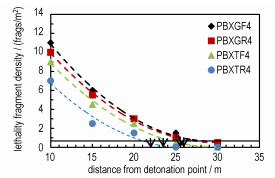
Polymer bonded explosive(PBX)formulations were successfully prepared in the laboratory scale containing 1, 1-diamino-2, 2-dinitroethene(FOX-7) and hexogen(RDX) as brisant high explosives and different binder types of polyurethane(PU)based on glycidyl azide polymer(GAP)and hydroxyl-terminated polybutadiene(HTPB)as an energetic and inert polymeric binder respectively. The sensitivity to different initial impulses and performance characteristics of the explosive and lethal zone were studied.



